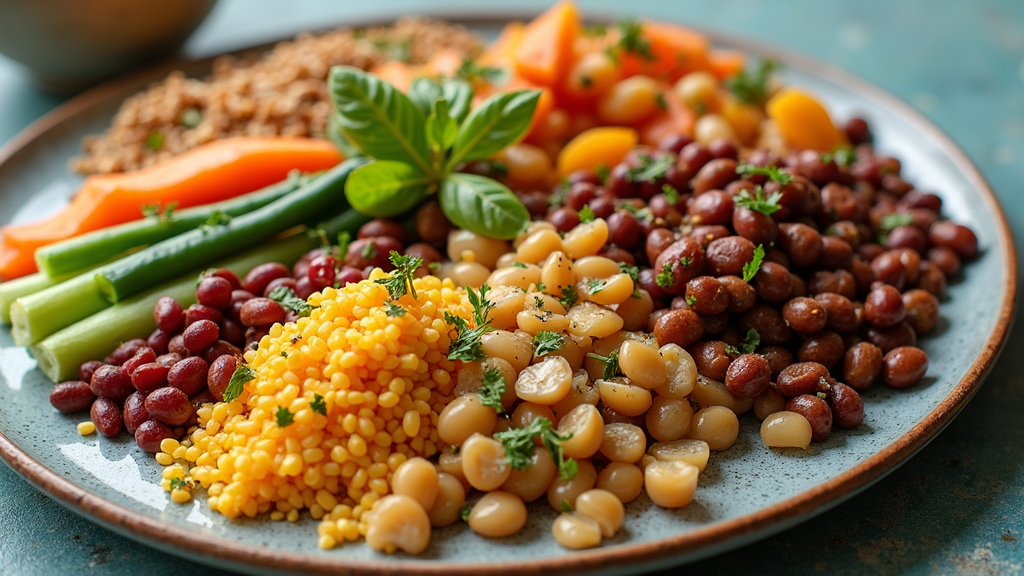Balancing your macronutrients in a plantbased meal plan can feel a bit tricky in the beginning, especially if you’re new to eating more plants. I’ve found that focusing on protein, carbs, and healthy fats in the right mix really helps support both energy and longterm health. Jumping in without a game plan might lead to unbalanced meals, but with a little insight and a handful of go to plant foods, building a satisfying and nutritionally complete plantbased routine is completely possible. Here, I’m breaking down what you need to know, along with some practical tips and common pitfalls to keep an eye on.

What Are Macronutrients (and Why Bother Balancing Them)?
Macronutrients are the nutrients your body needs in larger amounts: protein, carbohydrates, and fats. They all serve different functions in your body. Carbs fuel your brain and muscles. Protein builds and repairs tissues, and fats support brain health, hormones, and cell structure. When you’re eating mostly plants—or all plants—it sometimes takes a little more planning to make sure all these bases are covered.
A lot of folks wonder if plantbased diets can offer enough protein or the right amounts of fats. The short answer: absolutely, with mindful food choices. You won’t just be eating salads and fruit, but a mix of beans, grains, nuts, seeds, and veggies.
Key Food Groups for a Balanced PlantBased Plate
Plantbased eating isn’t just about skipping animal products; it’s about making sure your meals are built with a variety of wholesome foods. I’ve found these food groups make it really easy to hit the right macronutrient balance without stress:
- Legumes (lentils, chickpeas, beans, peas): packed with plant protein and fiber
- Whole Grains (quinoa, brown rice, oats, barley): steady energy from longlasting carbohydrates and some protein too
- Nuts & Seeds (almonds, chia, flaxseed, sunflower seeds): healthy fats, fiber, a little protein, and crunch
- Vegetables (leafy greens, broccoli, carrots, sweet potatoes): vitamins, minerals, and slowdigesting carbs
- Fruits (berries, apples, oranges, bananas): natural sugars, fiber, and plenty of antioxidants
Mixing from each group not only boosts nutrition but keeps meals interesting and filling. Pairing grains with beans isn’t just classic comfort food. It helps create a complete protein with all the amino acids your body loves.
How Much Protein, Carbs, and Fat Do You Actually Need?
Finding the right split depends a lot on your age, activity level, and goals, but for most adults, a common guide is:
- Carbohydrates: around 4565% of your daily calories
- Protein: around 1020% of your daily calories (a bit higher if you’re super active or older)
- Fat: around 2035% of daily calories (with a focus on unsaturated fats)
For plantbased eaters, getting enough protein is one of the most common questions. I’ve found this is totally doable with a little label reading and, sometimes, creative meal planning. Think about adding hemp hearts to oatmeal or choosing edamame for a snack.
Government resources like NHLBI can give you a ballpark for your individual needs.
Building PlantBased Meals With Balanced Macros
Staying balanced doesn’t mean overthinking every meal. What’s helped me most is using a basic meal template. Half my plate is vegetables or fruit, a quarter is whole grains, and a quarter is legumes or tofutempeh. A sprinkle of nuts or a drizzle of olive oil brings in those good fats. Here’s how that can look in real life:
- Burrito Bowl: Brown rice + black beans + lettuce, salsa, avocado, and corn
- Chickpea StirFry: Chickpeas + sautéed broccoli and carrots + quinoa + sesame seeds
- Breakfast Oats: Rolled oats + chia seeds + almond butter + berries
Paying attention to portion sizes matters, especially with caloriedense foods (like nut butters), but there’s plenty of room for satisfying meals. Planning ahead—batchcooking beans, roasting extra vegetables, or prepping overnight oats—makes staying balanced way easier throughout the week.
Challenges To Watch Out For (and Easy Fixes)
Eating plantbased isn’t always totally smooth sailing. Here are a few common issues I hear about, along with some simple solutions that work for me and others:
- Not Enough Protein: If meals feel light or you’re hungry right after eating, upping beans, lentils, tofu, or quinoa can make a big difference. Even adding a scoop of plantbased protein powder to a smoothie can be helpful on really busy days.
- Going Too Low on Fat: Fat keeps you satisfied and helps absorb certain vitamins. I always keep nuts, seeds, and avocado handy. Adding a spoonful of nut butter to oatmeal or tossing seeds on salad really helps here.
- Sticking Only to Carbs: Pasta and bread are delicious but alone can leave you with energy crashes. Toss in beans or peas, or use lentilbased pastas for more protein.
- Lack of Variety: Eating the same three salads and grain bowls might get boring fast, and you could miss out on key nutrients. Exploring new cuisines, like Thai, Indian, or Ethiopian vegetarian dishes, has really helped me bust ruts while keeping nutrients high.
Protein Myths and Quick Sources
I hear a lot of myths about plantbased protein. A common one is that vegan or plantbased diets can’t provide enough complete protein. Truth is, if you’re eating a varied menu, getting all the essential amino acids isn’t hard. Great sources packed with protein include:
- Tempeh and tofu
- Seitan (wheat meat)
- Soy milk
- Lentils and split peas
- Pumpkin seeds and peanuts
Mixing different foods throughout your day covers all your bases. You can also mix in variety by trying new lentil dishes or experimenting with baked tofu recipes. When you add color and creativity, you boost nutrition and keep meals from feeling repetitive.
Healthy Fats On a PlantBased Diet
Healthy fats are easy to add through plant sources. I focus on these options:
- Avocados
- Olives and olive oil
- Walnuts, almonds, cashews
- Chia, flax, and hemp seeds
Omega3s sometimes need special attention, especially the EPA and DHA forms. I use ground flaxseed and chia seed regularly. Algae oil is another plantbased option for longchain Omega3. Coconut products also offer some healthy fat, though moderation is key.
Macros in Everyday PlantBased Recipes
Seeing how macronutrients break down in a few simple meals can help you picture a balanced plate. Here are three plantpowered options that do the trick:
- Red Lentil Soup (protein and carbs, light on fat, but add a drizzle of olive oil as you serve to step up flavor and nutrition)
- Stuffed Sweet Potatoes (black beans, corn, avocado—plenty of each macro group for a hearty, satisfying meal)
- Quinoa Tabbouleh with Chickpeas (protein from chickpeasquinoa, carbs from quinoa, fats from olive oil)
Using nutrition tracking apps for a few days helps brighten up your view of macro intake if you’re curious or just want a checkin. Apps can also help spot any nutrients you might miss, letting you tweak your meals as needed. If you’re new, try tracking a week of meals for more insights about your choices.
Frequently Asked Questions
Here are some things people often ask when getting started with macronutrient balance on a plantbased meal plan:
Question: How can I make sure I’m getting complete protein each day?
Answer: Eating a mix of legumes, grains, nuts, and seeds throughout your day supplies all the essential amino acids. There’s no need to combine everything at a single meal.
Question: What’s the easiest way to include more healthy fat?
Answer: Try adding nuts or seeds to salads, oatmeal, or smoothies, and use avocado or a splash of olive oil regularly in cooking or dressings.
Question: Do I need to count every gram of protein, carbs, and fat?
Answer: Not usually! Focusing on a variety of whole plant foods and using your plate as a visual guide works well for most people. Tracking can be handy for athletes or for anyone with specific health goals.
Optimizing PlantBased Macros for Your Goals
Tweaking your macronutrient ratio can help if you have certain goals, like building muscle, losing weight, or supporting endurance training. For instance, if you’re trying to add muscle, you may want to boost your protein portion a bit and eat hearty meals with beans, tofu, and whole grains more often. Anyone focusing on endurance (like runners or cyclists) might do better with slightly higher carb intake from sweet potatoes, oats, and brown rice. The key is staying flexible and checking in on how you feel after meals. Don’t be afraid to mix in some variety by swapping protein sources or switching up your grain choices to find what gives you lasting energy and satisfaction.
Balancing macronutrients in a plantbased meal plan ends up being pretty straightforward once you have the basics down. Looking for a colorful mix of plants at every meal, eating from every food group, and watching for signs you need more of one macro or another makes it simple to build a healthy routine that actually feels satisfying. Swapping tips with other plantbased eaters or working with a registered dietitian for personal guidance (especially if you have any medical concerns) is really helpful for longterm success. The bottom line: With a little knowledge and some tasty staple ingredients, anyone can build an energizing, plantbased menu that checks all the right boxes for nutrition and flavor.
